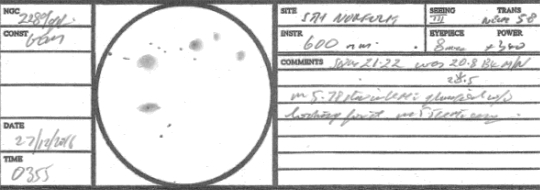January 2017 - Galaxy of the Month
NGC 2289 Group in Gemini
Winter is never an easy time to select galaxies for the GOM column as we are mostly looking into the Milky Way areas. There are however a number of galaxies near the head of Gemini and this month’s challenge is the small group of galaxies around NGC 2289.
The group appears to be a physical one and is listed as WBL 126, which consists of the five galaxies NGC 2288, 2289, 2290, 2291 and 2294. Unfortunately this is a pretty faint group and as such will be a challenge for larger telescopes and will probably require telescopes in the region of 37cm aperture plus to see visually.
William Herschel discovered NGC 2289 and NGC 2290 with his 18.7” reflector in the spring of 1793 but the other three galaxies in the group were found by George Stoney using Lord Rosse’s 72” reflector at Birr when following up nebulae discovered by the Herschels. Some sources suggest that NGC 2291 was discovered by John Herschel but this is almost certainly an error and he only saw the two galaxies his father saw. NGC 2290 may be the brightest galaxy in the group.
The group were photographed early on by Francis Pease using the 60” reflector at Mt Wilson in 1920. In his paper Photographs of Nebulae with the 60-inch Reflector, 1917–1919
he interestingly thinks they are all spirals. Of course at this time it was still unknown whether the nebulae were inside our own galaxy. Hubble’s observations were still a few years in the future.
The group is fairly tightly concentrated and all the galaxies will fit in the field of a high power, 300x, eyepiece. The group consists of three lenticulars, one spiral and an unknown type (NGC 2288, although possibly this is an E5). My suspicions are that NGC 2288 is going to be the most challenging of the galaxies to see.
The distance to the group appears to be about 70 Mpc distant. There is some galactic extinction in this area which could be a contributing factor in the faintness of these galaxies as they don’t lie completely outside the Milky Way. I was surprised to find that, despite its faintness, the group is part of the Astronomical League's Galaxy group and clusters observing program.
Perhaps not surprisingly given the groups faintness there have been few studies made of the group apart from statistical ones to show it is a group. Given its faintness it is perhaps no surprise that it does not appear in the Night Sky Observer's Guide (NSOG) but Steve Gottlieb has observed all the galaxies in this group and his observations can be found on his website.

Owen Brazell - Galaxy Section Director